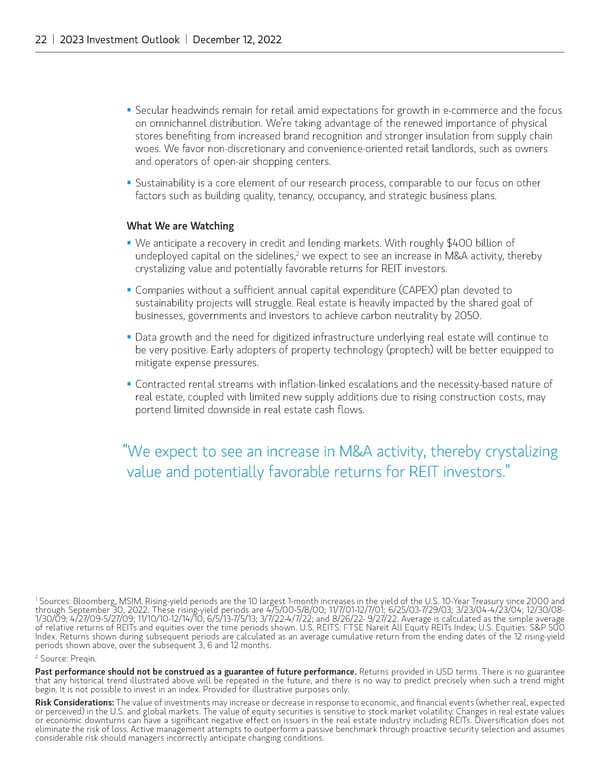22 | 2023 Investment Outlook | December 12, 2022 ƒ Secular headwinds remain for retail amid expectations for growth in e-commerce and the focus on omnichannel distribution. We’re taking advantage of the renewed importance of physical stores benefiting from increased brand recognition and stronger insulation from supply chain woes. We favor non-discretionary and convenience-oriented retail landlords, such as owners and operators of open-air shopping centers. ƒ Sustainability is a core element of our research process, comparable to our focus on other factors such as building quality, tenancy, occupancy, and strategic business plans. What We are Watching ƒ We anticipate a recovery in credit and lending markets. With roughly $400 billion of 2 undeployed capital on the sidelines, we expect to see an increase in M&A activity, thereby crystalizing value and potentially favorable returns for REIT investors. ƒ Companies without a sufficient annual capital expenditure (CAPEX) plan devoted to sustainability projects will struggle. Real estate is heavily impacted by the shared goal of businesses, governments and investors to achieve carbon neutrality by 2050. ƒ Data growth and the need for digitized infrastructure underlying real estate will continue to be very positive. Early adopters of property technology (proptech) will be better equipped to mitigate expense pressures. ƒ Contracted rental streams with inflation-linked escalations and the necessity-based nature of real estate, coupled with limited new supply additions due to rising construction costs, may portend limited downside in real estate cash flows. “We expect to see an increase in M&A activity, thereby crystalizing value and potentially favorable returns for REIT investors.” 1 Sources: Bloomberg, MSIM. Rising-yield periods are the 10 largest 1-month increases in the yield of the U.S. 10-Year Treasury since 2000 and through September 30, 2022. These rising-yield periods are 4/5/00-5/8/00; 11/7/01-12/7/01; 6/25/03-7/29/03; 3/23/04-4/23/04; 12/30/08- 1/30/09; 4/27/09-5/27/09; 11/10/10-12/14/10; 6/5/13-7/5/13; 3/7/22-4/7/22; and 8/26/22- 9/27/22. Average is calculated as the simple average of relative returns of REITs and equities over the time periods shown. U.S. REITS: FTSE Nareit All Equity REITs Index; U.S. Equities: S&P 500 Index. Returns shown during subsequent periods are calculated as an average cumulative return from the ending dates of the 12 rising-yield periods shown above, over the subsequent 3, 6 and 12 months. 2 Source: Preqin. Past performance should not be construed as a guarantee of future performance. Returns provided in USD terms. There is no guarantee that any historical trend illustrated above will be repeated in the future, and there is no way to predict precisely when such a trend might begin. It is not possible to invest in an index. Provided for illustrative purposes only. Risk Considerations: The value of investments may increase or decrease in response to economic, and financial events (whether real, expected or perceived) in the U.S. and global markets. The value of equity securities is sensitive to stock market volatility. Changes in real estate values or economic downturns can have a significant negative effect on issuers in the real estate industry including REITs. Diversification does not eliminate the risk of loss. Active management attempts to outperform a passive benchmark through proactive security selection and assumes considerable risk should managers incorrectly anticipate changing conditions.
 Morgan Stanley 2023 Investment Outlook Page 21 Page 23
Morgan Stanley 2023 Investment Outlook Page 21 Page 23